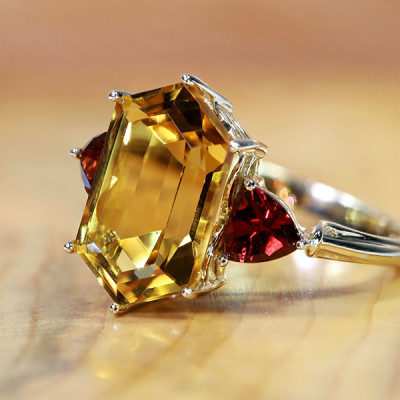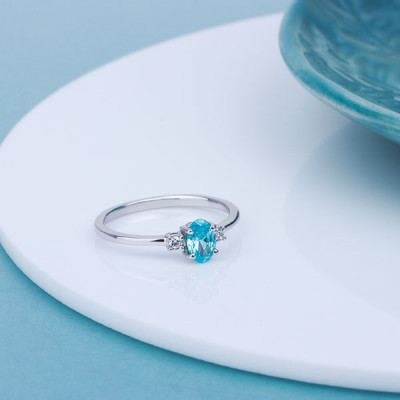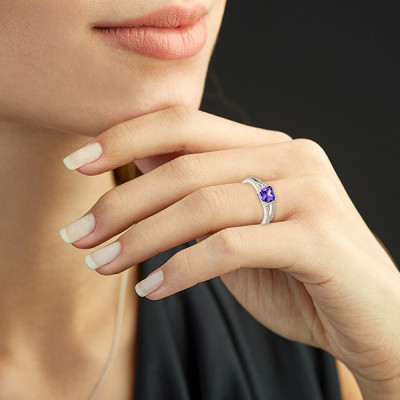AQUAMARINE GUIDE
(MARCH BIRTHSTONE)
Aquamarine is a beautiful gemstone cut from the mineral beryl, in the green-blue to blue variety. It's a stunning stone that is known for its large size and cleanliness. The durability of aquamarine makes it particularly valuable to jewellers, while its well-formed structure makes it attractive to collectors of mineral specimens.
Aquamarine is a very rare stone, especially in terms of its colour and source. Its rarity, size, high quality and long history as a gem make it a very desirable stone too. However, it's also expensive. Much more expensive than a common stone such as blue topaz, it’s worth every penny due to its rich history and beautiful colour.
Aquamarine is also the birthstone for March, and the symbolism behind it is that it represents happiness, hope and everlasting youth. If you’re looking for a beautiful gemstone with meaning, then aquamarine is the one for you!
History and meaning of aquamarine
Due to its light blue and green complexion, which mimics the natural beauty of the sea, this gorgeous gem gets its name from the Latin translation for water. In ancient times, the aquamarine stone was believed to calm the waves of the sea and keep sailors safe on their journeys. That’s why many people, when gifted aquamarine, see it as a sign of health and safety.
The mineral it derives from is beryl, which was traditionally thought to give its wearer protection against foes in battle or litigation. It’s also thought to quicken intellect, while some believe it enhances happiness in marriages.
Physical properties of aquamarine
When it comes to understanding gemstones, we have to take their physical and optical properties into account. The physical properties are index of refraction, dispersion, specific gravity, hardness, cleavage and fracture, while the optical properties are colour, lustre and transparency.
Aquamarine has a chemical composition of Be3AI2Si6O18. It contains no or few inclusions, but if there are any, it will have inclusions of mica, hematite and saltwater.
Index of refraction: 1.563 - 1.583
Dispersion: Low
Specific gravity: 2.68 - 2.80
Hardness: 7.5 - 8.0
Cleavage: imperfect
Fracture: conchoidal to uneven, brittle
Colour: blue to blue-green to sea-green
Lustre: vitreous, although some specimens have chatoyancy
Transparency: transparent to translucent
Aquamarine jewellery style tips
When it comes to styling aquamarine jewellery, it’s very hard to go wrong. Such a beautiful gem with delicate colour compositions tends to be very complementary. However, our advice would be to avoid wearing it every day and save it for special occasions instead. Aquamarine is not made to withstand the bumps, knocks and wear and tear of day-to-day life, which is why we also don’t usually recommend it for an engagement ring.
With its light blue and greenish colour, aquamarine can often appear icy due to its cool undertones. For some people’s wardrobes, this works perfectly, but for others, not so much. If you usually wear a warmer colour palette, this doesn’t mean you can’t enhance your look with aquamarine jewellery. In this case, we'd recommend wearing aquamarine jewellery that has warm gold or rose gold accents or bands (for rings). This is because this warmer metal will go nicely with the aquamarine and your warmer colour palette, tying the whole look together.
Care and maintenance of aquamarine jewellery
Your aquamarine jewellery needs to be handled with care as it's very delicate. As we've already mentioned, we don’t recommend it for everyday use and when you store your jewellery, make sure they are kept out of the sun.
A key part of maintaining aquamarine jewellery is cleaning. However, you should never use chemicals. Only use warm water mixed with a little bit of mild dish soap, soaking your jewellery for 30 minutes. Then, use a toothbrush to gently scrub the jewellery before rinsing it off with clean water and drying it with a cloth. It’s recommended that you do this after every 3rd or 4th wear.
Faq
Aquamarines will vary in price depending on the type of jewellery you're looking for and the carat. As a rough guide, a 1-carat aquamarine would typically cost around £500 - £600.
Yes, fine aquamarine is a typically expensive stone due to its high value and rarity.
As long as it’s treated with care and is protected against scratching and hard knocks, aquamarine is a suitable gemstone for jewellery. It has a 7.5 - 8 rating on the Mohs scale.
Traditionally, the fourth or middle finger is reserved for larger gemstones such as aquamarine.
When it comes to aquamarine, the purer and more intense the blue is, the more valuable the stone.
The best way to identify if it’s real is by looking at the colour. It should be blue with hints of green - like seawater. Naturally occurring gems typically have excellent clarity and transparency.
Blue to slightly greenish blue.
Aquamarine represents happiness, hope and everlasting youth, so when someone gifts you aquamarine, they likely wish this for you.
Typically, the rarest colour of aquamarine is a deep blue, arguably the “Santa Maria” deep blues from Brazil.
Preferably, you'd be better off choosing a different gemstone, especially if you want to wear the ring every day. Aquaramine will not survive the wear and tear of everyday life.
Browse All 12 Birthstone Guides
-

Garnet
January Birthstone -

Amethyst
February Birthstone -

Aquamarine
March Birthstone -

Diamond
April Birthstone -

Emerald
May Birthstone -

Pearl
June Birthstone -

Ruby
July Birthstone -

Peridot
August Birthstone -

Sapphire
September Birthstone -

Opal
October Birthstone -

Topaz
November Birthstone -

Tanzanite
December Birthstone

Article written by Nilesh
 Trustpilot
Trustpilot



